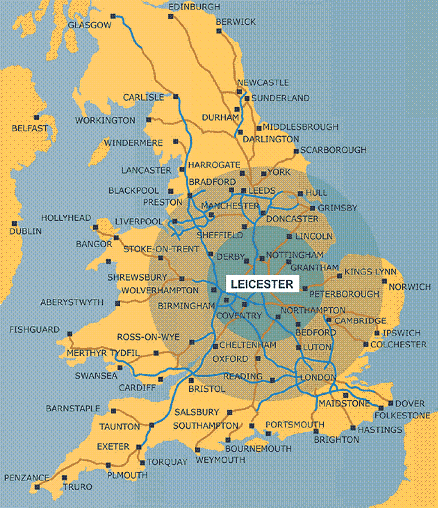Authorities here and the University
of Leicester have undertaken several projects to promote
the region as a destination for the Indian film industry....More
Leicester City
With a population of 280,000, Leicester is the largest
city in the East Midlands and the tenth largest in
the country.
Leicester has a large multi-ethnic population, mainly
NRI. (non-resident Indians). There are many Hindu
temples, Sikh gurdwaras and Muslim mosques around
the city, mostly converted from existing buildings.
The only Jain Temple in the western world is near
the city centre (The Jain Centre). The area around
Belgrave Road is known as the Golden Mile, and contains
many Indian restaurants, jewellery shops, and other
shops catering to the large Asian community in the
neighbourhood. Many people travel to the area specifically
for the restaurants, which serve authentic Indian
cuisine. The annual Diwali celebrations are also held
here and at the nearby Abbey Park, and are the biggest
outside of India. There are also many of Afro-Caribbean
descent (mainly from Antigua & Barbuda, Montserrat
and Jamaica), the community being centred around Highfields
to the southeast of the city centre, and Leicester
plays host to the second-largest Caribbean Carnival
in the UK after Notting Hill.

Leicester is well known for enjoying the largest
percentage of Hindus in the UK (25.7%) and is renowned
for celebrating the event in its own unique way.
The latest nationwide census is expected to show
that by 2011 Leicester will become the first UK city
where 50% of the population will hail from a non-white
background
Its importance was first recognised by the Romans
and later by the Danes, who used it as a strategic
stronghold to control the Midlands. Since then it
has developed into a major commercial and manufacturing
centre, known better for the diversity of its trade
than for its dependence on a single industry.
It is also a historic meeting place. For centuries
people of different races and cultures have gathered
in Leicester, creating a rich and unique heritage.
This diversity continues today. The city's thriving
ethnic minority community accounts for more than a
third of Leicester's population and continues to enrich
city life.
The Martyrs is in an inner city area, about fifteen
minutes walk from the centre of Leicester. The main
road that links Leicester with the M1/M69 at Junction
21 runs through the parish (the A5460). Leicester
is Britain’s tenth largest town/city.
The parish has a mixture of housing – many small
and medium-sized Victorian terraces, and some pre-war
semi-detached housing. A number of the larger Victorian
houses are used as hostels – for the mentally
handicapped, children in care, bail hostels, women’s
refuge and numerous homes for the elderly.
Until recently the area has been part of a City Challenge
regeneration scheme. This has brought, and is bringing,
many tens of millions of investment and development
money into the area.
It is set to become a major city with many developments
on the horizon implemented by the Leicester Regeneration
Company including a major theatre designed by Rafael
Viñoly.
In 1990 Leicester was designated the UK's first Environment
City, and won the European Sustainable City Award
in 1996.